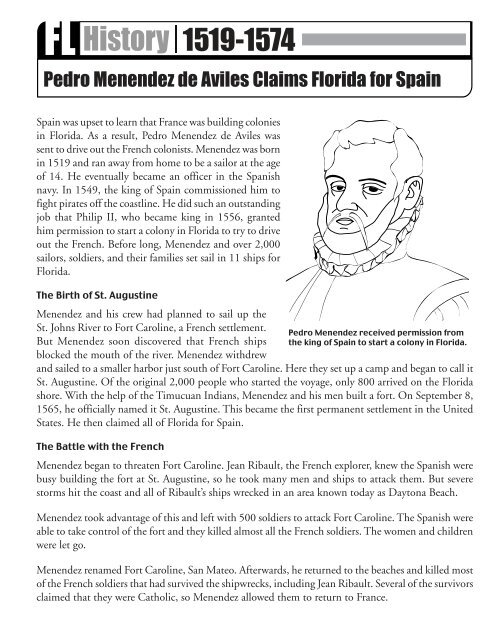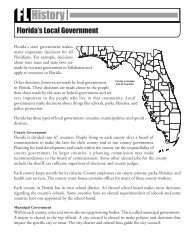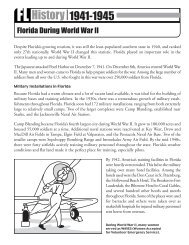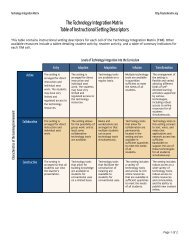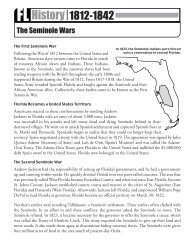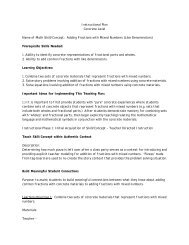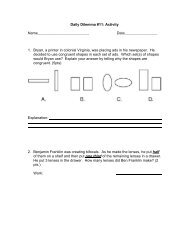FLHistory 1519-1574
FLHistory 1519-1574
FLHistory 1519-1574
- No tags were found...
Create successful ePaper yourself
Turn your PDF publications into a flip-book with our unique Google optimized e-Paper software.
FL History <strong>1519</strong>-<strong>1574</strong><br />
Pedro Menendez de Aviles Claims Florida for Spain<br />
Spain was upset to learn that France was building colonies<br />
in Florida. As a result, Pedro Menendez de Aviles was<br />
sent to drive out the French colonists. Menendez was born<br />
in <strong>1519</strong> and ran away from home to be a sailor at the age<br />
of 14. He eventually became an officer in the Spanish<br />
navy. In 1549, the king of Spain commissioned him to<br />
fight pirates off the coastline. He did such an outstanding<br />
job that Philip II, who became king in 1556, granted<br />
him permission to start a colony in Florida to try to drive<br />
out the French. Before long, Menendez and over 2,000<br />
sailors, soldiers, and their families set sail in 11 ships for<br />
Florida.<br />
The Birth of St. Augustine<br />
Menendez and his crew had planned to sail up the<br />
St. Johns River to Fort Caroline, a French settlement.<br />
But Menendez soon discovered that French ships<br />
blocked the mouth of the river. Menendez withdrew<br />
and sailed to a smaller harbor just south of Fort Caroline. Here they set up a camp and began to call it<br />
St. Augustine. Of the original 2,000 people who started the voyage, only 800 arrived on the Florida<br />
shore. With the help of the Timucuan Indians, Menendez and his men built a fort. On September 8,<br />
1565, he officially named it St. Augustine. This became the first permanent settlement in the United<br />
States. He then claimed all of Florida for Spain.<br />
The Battle with the French<br />
Pedro Menendez received permission from<br />
the king of Spain to start a colony in Florida.<br />
Menendez began to threaten Fort Caroline. Jean Ribault, the French explorer, knew the Spanish were<br />
busy building the fort at St. Augustine, so he took many men and ships to attack them. But severe<br />
storms hit the coast and all of Ribault’s ships wrecked in an area known today as Daytona Beach.<br />
Menendez took advantage of this and left with 500 soldiers to attack Fort Caroline. The Spanish were<br />
able to take control of the fort and they killed almost all the French soldiers. The women and children<br />
were let go.<br />
Menendez renamed Fort Caroline, San Mateo. Afterwards, he returned to the beaches and killed most<br />
of the French soldiers that had survived the shipwrecks, including Jean Ribault. Several of the survivors<br />
claimed that they were Catholic, so Menendez allowed them to return to France.
<strong>1519</strong>-<strong>1574</strong><br />
The Watchtowers and the Forts<br />
The inlet where Menendez and his men killed the shipwrecked soldiers was called Mantanzas. It is a<br />
Spanish word that means slaughters. In 1569, a wooden watchtower and a fort were built on the<br />
Mantanzas Inlet. The watchtower was used as a lookout for British ships.<br />
Pedro Menendez became Florida’s first Spanish Colonial Governor. He wanted to make sure that all of<br />
Florida stayed under Spain’s control. In order to do this, he began to explore and to establish outposts<br />
up and down the Atlantic coast. In 1566, Menendez had watchtowers built at Cape Canaveral and<br />
Biscayne Bay.<br />
Next, Menendez sent two ships of settlers to what is now Paris Island, South Carolina. In 1569, more<br />
settlers arrived there and the town began to bloom. It was named Santa Elena and became the capital<br />
of Spanish Florida. By building a string of forts along both coasts, Menendez helped the Spanish<br />
control Florida for many years.<br />
The Native Americans and the Spanish Missionaries<br />
Menendez was successful in signing a treaty, or agreement, with the Calusa Indians to trade gold for<br />
food and other supplies his troops needed to survive. Menendez was a staunch Roman Catholic, and<br />
one of his goals was to convert Native Americans to the Catholic faith. He requested that all ships<br />
coming from Spain carry priests. These priests became missionaries, which led to the period of Spanish<br />
missions in Florida history. Menendez went back to Spain to collect more settlers, but died on September<br />
17, <strong>1574</strong>, before he could return to Florida.<br />
SEPTEMTRIO.<br />
OCCIDENS.<br />
ORIENS.<br />
“La Florida” included the<br />
entire eastern half of<br />
North America on this<br />
Spanish map from 1584.<br />
LA FLORIDA.


